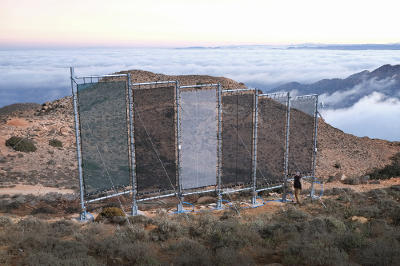Using AI to control energy for indoor agriculture
30 September 2024
Published online 16 May 2016
Moroccans are turning to an unconventional source in response to the country’s water crisis.

In some ways the NGO has transformed life in several surrounding villages.
Morocco is facing a water deficit. On average, residents have access to less than a tenth as much fresh water as the average European resident, though the shortfall is felt unevenly throughout the population. Urban elites, largely unaware of a water shortage, enjoy swimming pools and frequently wash their cars, while people in some of the poorer rural communities get by with just a few litres of freshwater per day.
In an effort to help some of these disenfranchised communities, Dar Si Hmad has joined with NGOs in Canada and Germany to establish a fog harvesting farm serving villages on Mount Boutmezguida.
“These people have lived with water constraints for centuries, but less and less water has become available because of cycles of drought,” explains Jamila Bargach, the project’s director.
To collect fog, a taut mesh is suspended several metres above the ground. Wind pushes fog through the mesh, causing floating droplets to hit the mesh, collect, and run into a gutter below.
Canadian NGO FogQuest says a single cubic meter of fog usually carries between 0.05 and 0.5 grams of liquid water. Higher wind speeds drive more water in the collector’s trough but are also more likely to damage the mesh.
The fog collectors installed on Mount Boutmezguida are based on technology from FogQuest. “For us, one of the major issues with the current design is wind, which tears the fog nets, and then we have to go up and change them. It’s a Sisyphean job,” says Bargach.
Despite challenges, the fog collectors harvest enough water from the abundant fog for the villagers to have tripled their average daily consumption. In addition, women and girls no longer have to spend much of the day hauling water from wells.
Dar Si Hmad is working with the Water Foundation, a German NGO, to test next-generation fog collectors.
Fog collector systems need to combine strength and flexibility, explains Peter Trautwein, head of the Water Foundation’s commercial arm, Aqualonis, who designed the new collectors. Adding a support grid behind the mesh prevents it from losing water through billowing in the wind, while using rubber expanders to attach the mesh and trough to the framework enables them to flex together in the face of strong winds, reducing their impact.
Trautwein has also been testing the performance of different mesh materials. Working with Dar Si Hmad, he established a test site on Mount Boutmezguida from which data is sent to the Technical University of Munich for analysis. Over two years the team tested nearly a dozen different meshes and finally settled on a design using spacer fabric, which is loose enough to let the fog pass through, and dense enough to capture most of the water.
The new CloudFisher design has been through its paces at the test sites, and in October the team will start building the largest fog farm in the world —1,600m² of mesh, which will collect around 36,000 litres of water on a foggy day.
The new farm will demonstrate the technology’s viability and reliability. When complete, it should provide 18 litres of clean fresh water per day to 630 people spread across seven villages.
“It's wonderful to see people’s faces when the water starts to run. I know people who spent four to six hours each day collecting water. You know, if you see those faces just once in your life, that's enough,” says Trautwein. “That's perfect.”
doi:10.1038/nmiddleeast.2016.67
Stay connected: